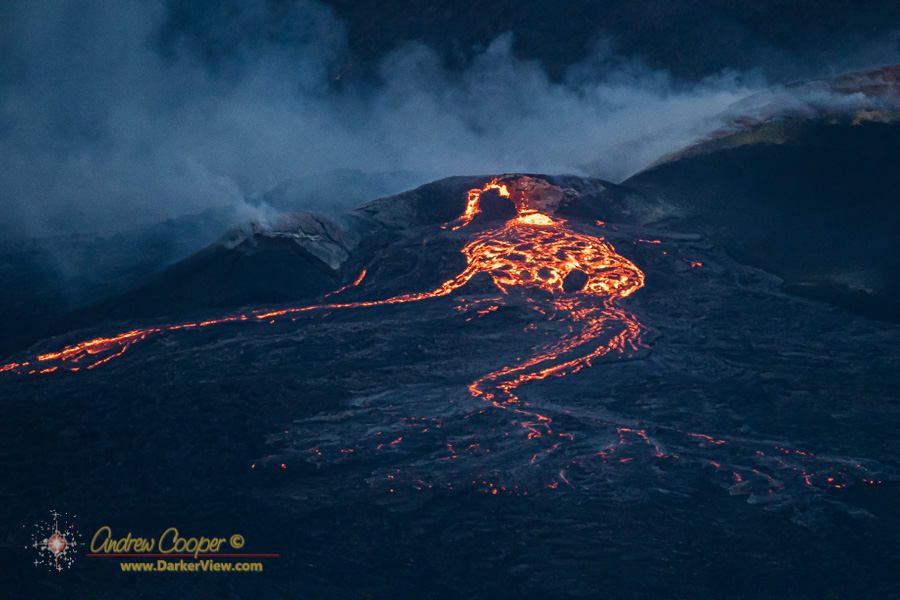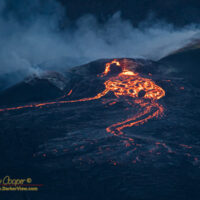
Tag: lava
Waiting for Episode 36
It was going to be Sunday.
Regular checking of the tiltmeter data, watching the glow and spatter in the livestream cameras, and nearly a year of experience with the current eruption’s repetitive episodes had allowed me to be fairly certain. Others were betting it would be Friday or Saturday. Some folks had been camping out on the volcano for days. I was sure… Sunday, probably Sunday morning.
Thus I readied the camera gear, made sure the car was fully fueled, and got to bed early Saturday evening for an early morning run.
Continue reading “Waiting for Episode 36”Bubbling Caldron

Lava Fountain

Volcano Run… Not
I was ready…
I had the day off, and the eruption was due. The camera was packed, batteries charged, memory cards cleared. Ready to go!
Work, as usual, is the complicating factor when it comes to volcano photography. I had been planning for a week. Some experiments at work required me to go in on Saturday. This giving me a chance to trade for a day for off in the middle of the week. Careful checking of the USGS telemetry showed that day would be Tuesday. Thus I arranged Tuesday off and was ready to go…
Continue reading “Volcano Run… Not”End of the Road
A number of roads I once drove have been claimed by volcanoes over the years.
Crater Rim Drive literally collapsed into Kilauea Caldera, the road, viewpoints, trailheads… All gone. Highway 132, Pohoiki road, Kopoho Road, all buried during the 2018 eruption. Sections of Highway 130 near Kalapana, slowly covered by the Puʻu Oʻo eruptions flowing to the sea.
And the Mauna Loa access road, cut by the 2022 Mauna Loa eruption.
How many times did I travel this road? Quite a few… Trips up to set up my own telescope near the NOAA research station. Contracting work at the NOAA station in the wake of the pandemic. A couple trips up just to enjoy the scenery or do a little photography.
Then an eruption, the first eruption of Mauna Loa in near four decades. The lava flows cut the road in two places.
I had not been up to where the lava crossed the road since the eruption. That was until until this last weekend. I finally got up there… No reason, just enjoying the mauna on a pretty Sunday morning. I parked down below and rode the bike the last few miles up to the lava flow.
As expected the road just vanishes under the lava. An impressive pile of aʻa clinkers covers the road twenty feet deep. Three years later I am rather surprised the road has not been re-cut into the observatory.
Here it is, lava across the road, power lines dangling, as far as you can go unless you are willing to abuse yourself crossing 300 yards of jagged aʻa. I sent the drone for a look.

The Start
I somehow always miss the very start of the eruption.

For episode 9 I was just a couple miles away in another part of the park when the eruption broke out.
For episode 15 I had been on the rim for hours waiting for the expected start when I finally gave up and went to grab breakfast. The eruption started while I was waiting for my omlette at the Crater Rim Cafe.
This time I saw it.
Continue reading “The Start”Fountain

Fountain

Episode 15
Reading the tiltmeter data it was clear that the pressure was building again, an eruption appearing likely in the next day or two. The last episodes have produced ever higher lava fountains, I expect episode 15 to go even higher and I truly wish to see it when it happens.
Right on schedule the first lava appeared, a little rivulet of lava overflowing the north vent onto the crater floor. If the pattern repeated this would be followed by high lava fountains in the next ten hours or so. Episode 15 was on.
Tomorrow it would be, and as tomorrow was also a holiday for me, Prince Kūhiō Day, I would be free to make another volcano run!!
We are a go.
The same plan… a 2am alarm, hit the road, 4am in the park, hike to the Keanakāko’i viewpoint.
Continue reading “Episode 15”


